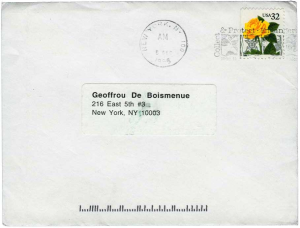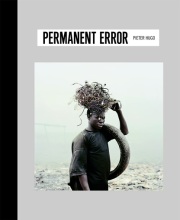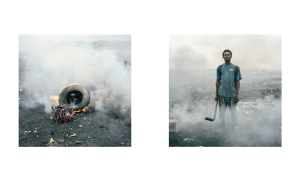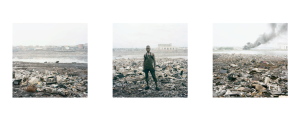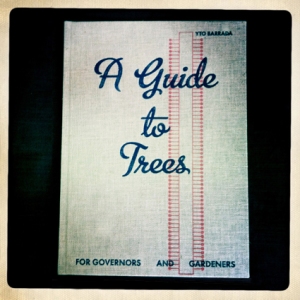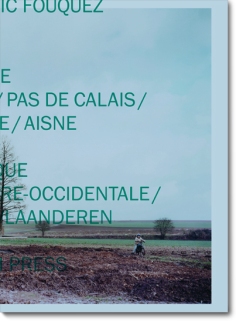 For years Aymeric Fouquez has photographed military cemeteries from World War I in the north of France and Belgium. His style – detached and cold – is documentary. His subject, however, is autobiographical: growing up in the north of France, Fouquez was often taken by his grandmother to play in a neighborhood cemetery. It was a closed space, peaceful and safe – even better than a park for keeping an eye a kid. This double reference to the past – to capital-H History and to a more intimate one – could be a potential snare to his photographic project. But Fouquez, far from being blandly nostalgic, focuses instead on the contemporary landscape. At the heart of this exploration is a group of 1,000 or so military cemeteries, impeccably groomed by British gardeners. They constitute a steady constant – a patch of memory around which everyday life evolves. He seems to be drawing a parallel with how we mentally file past grief, which cohabits in our minds alongside more mundane occupations.
For years Aymeric Fouquez has photographed military cemeteries from World War I in the north of France and Belgium. His style – detached and cold – is documentary. His subject, however, is autobiographical: growing up in the north of France, Fouquez was often taken by his grandmother to play in a neighborhood cemetery. It was a closed space, peaceful and safe – even better than a park for keeping an eye a kid. This double reference to the past – to capital-H History and to a more intimate one – could be a potential snare to his photographic project. But Fouquez, far from being blandly nostalgic, focuses instead on the contemporary landscape. At the heart of this exploration is a group of 1,000 or so military cemeteries, impeccably groomed by British gardeners. They constitute a steady constant – a patch of memory around which everyday life evolves. He seems to be drawing a parallel with how we mentally file past grief, which cohabits in our minds alongside more mundane occupations.
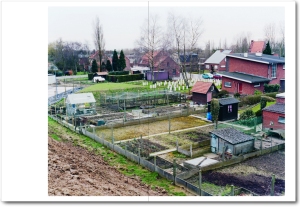 The cemeteries are barely visible in some of Fouquez’s photos: you strain to find them in the image. In others, they are front and center. But they are systematically posited as a counterpoint to the banality of modern life, set off against a highway, a “frituur” (fries stand), workers’ gardens, a warehouse or a vacant lot. For Foquez, these innumerable cemeteries do not represent an end in and of themselves; they are the storyline of a region which is, at best, ignored, but frequently caricatured.
The cemeteries are barely visible in some of Fouquez’s photos: you strain to find them in the image. In others, they are front and center. But they are systematically posited as a counterpoint to the banality of modern life, set off against a highway, a “frituur” (fries stand), workers’ gardens, a warehouse or a vacant lot. For Foquez, these innumerable cemeteries do not represent an end in and of themselves; they are the storyline of a region which is, at best, ignored, but frequently caricatured.
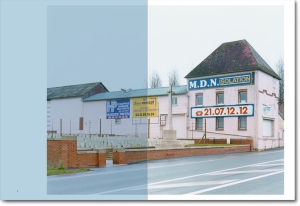 Mirroring Fouquez’s photographic finesse, the book itself transcends mere objecthood to become a piece of art. Fouquez’ practice could easily have led to a Becher-like “container” book – a hefty tome exhaustively and objectively cataloguing the images. Instead, Fouquez put his faith in the “artist’s book.” It all starts with paper choice. Nord is printed on both a blue-tinted matte stock, and on a sort of photographic paper, laminated on one side, matte on the other, and (surprisingly) printed on both. This purely material twist is somewhat confusing for the reader. To make matters worse, the six blue-tinted sheets (with printed text) are actually inserts: they “interrupt” the otherwise smooth succession of three double-page spreads. Photos are thus reproduced twice: once on the white paper, then again on the verso of the blue-colored insert. There’s more: to make each book unique, Fouquez inserts in every copy a different photogram excerpted from a 1977 super 8 film, a home movie of the future photographer romping around the Marquion military cemetery, just a hop, skip and jump from his grandmother’s house.
Mirroring Fouquez’s photographic finesse, the book itself transcends mere objecthood to become a piece of art. Fouquez’ practice could easily have led to a Becher-like “container” book – a hefty tome exhaustively and objectively cataloguing the images. Instead, Fouquez put his faith in the “artist’s book.” It all starts with paper choice. Nord is printed on both a blue-tinted matte stock, and on a sort of photographic paper, laminated on one side, matte on the other, and (surprisingly) printed on both. This purely material twist is somewhat confusing for the reader. To make matters worse, the six blue-tinted sheets (with printed text) are actually inserts: they “interrupt” the otherwise smooth succession of three double-page spreads. Photos are thus reproduced twice: once on the white paper, then again on the verso of the blue-colored insert. There’s more: to make each book unique, Fouquez inserts in every copy a different photogram excerpted from a 1977 super 8 film, a home movie of the future photographer romping around the Marquion military cemetery, just a hop, skip and jump from his grandmother’s house.
Published a few months back, Nord has gone relatively unnoticed, with the exception of the excellent magazine Foam. Slowly, however, this exacting work is on the path to becoming one of the most noteworthy photobooks of 2010.
RC
English translation by Kevin Jones
Aymeric Fouquez, Nord, Kodoji Press, stapled, 48 pages. 700 numbered and signed copies. Each copy has a different digital c-print insert.
Beyond
Nord at theVan Kranendonk gallery.
Kodoji Press temporary site.
Foam magazine
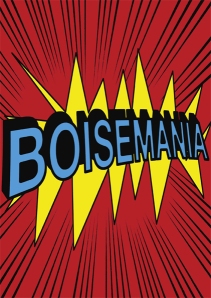 Contemporary narcissists get their ego-surf kicks by Googling their names. But photographer Geoffroy de Boismenu, harboring a fondness for paper and gifted with a sharp sense of self-parody, gives this old search a new twist. For years, he has saved letters, faxes, receipts and other bits and pieces bearing frightening misspellings of his moniker. The eponymous mishaps are legion – from “Geoffrou de Boismenue” to “Geoffrey de Boisemania” including “Geoffroi Breneu”! Amazingly, he has created an artist book from this orthographical mess. Boisemania, a generous tabloid format of 44 pages in an edition of 6,000, is available for free in Parisian spots from Colette to the Yvon Lambert gallery bookshop.Boisemania is a welcome diversion as we wait for Geoffroy de Boismeny’s (oops, Boismenu’s) new book Image System, published by RVB, expected this autumn.
Contemporary narcissists get their ego-surf kicks by Googling their names. But photographer Geoffroy de Boismenu, harboring a fondness for paper and gifted with a sharp sense of self-parody, gives this old search a new twist. For years, he has saved letters, faxes, receipts and other bits and pieces bearing frightening misspellings of his moniker. The eponymous mishaps are legion – from “Geoffrou de Boismenue” to “Geoffrey de Boisemania” including “Geoffroi Breneu”! Amazingly, he has created an artist book from this orthographical mess. Boisemania, a generous tabloid format of 44 pages in an edition of 6,000, is available for free in Parisian spots from Colette to the Yvon Lambert gallery bookshop.Boisemania is a welcome diversion as we wait for Geoffroy de Boismeny’s (oops, Boismenu’s) new book Image System, published by RVB, expected this autumn.
